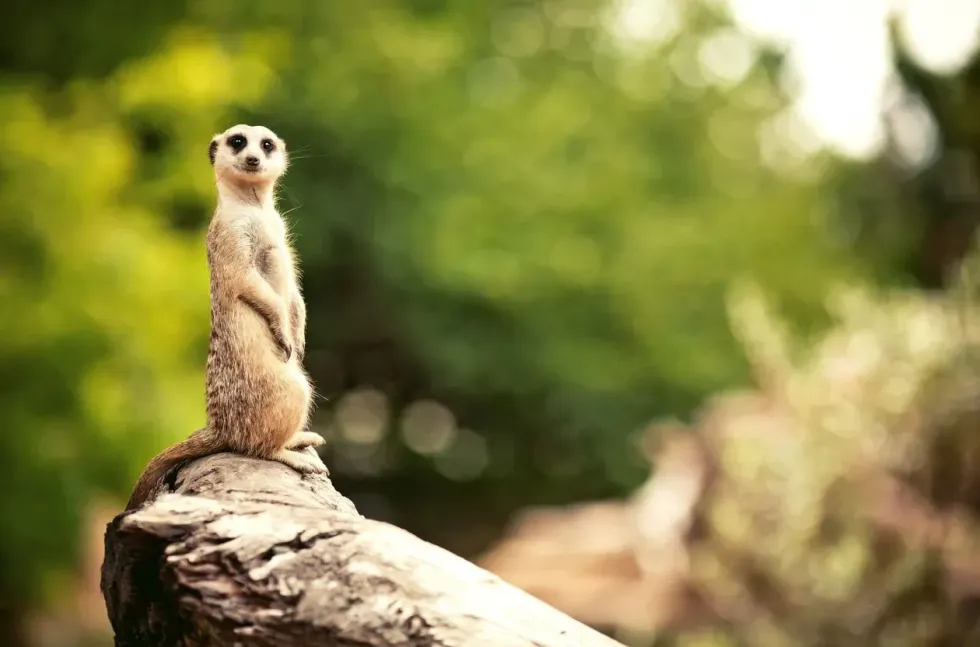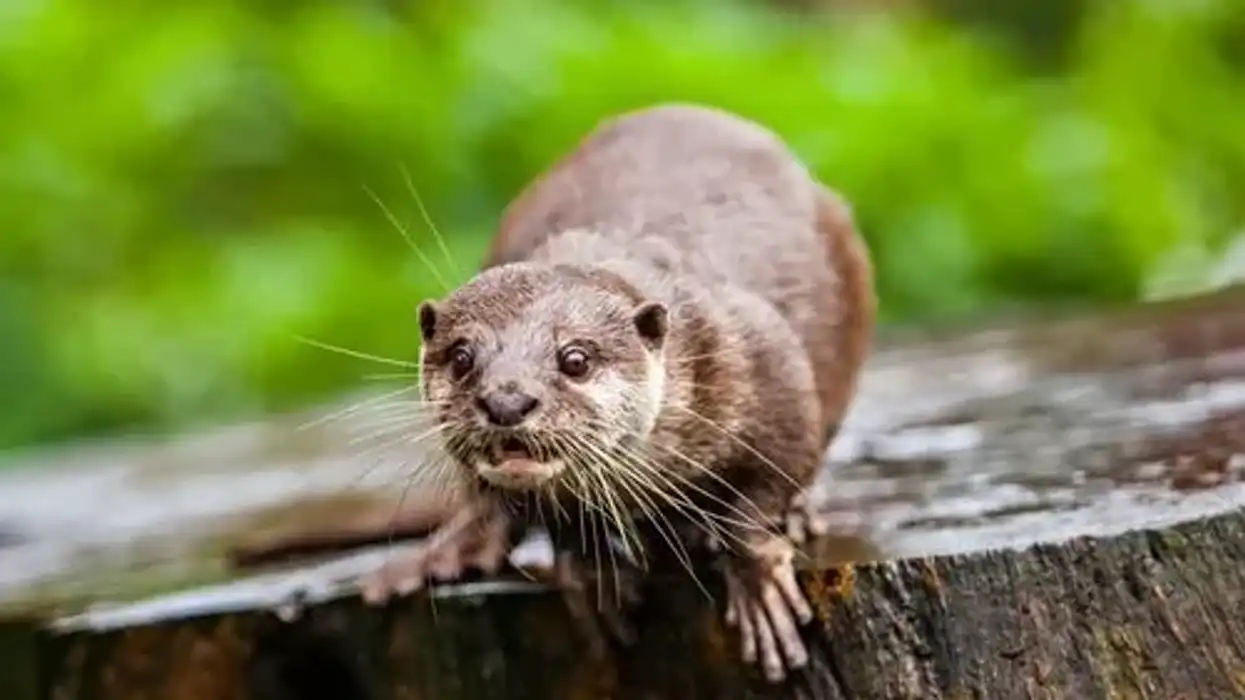Remember Timon from 'The Lion King'? Well, Disney may have immortalized the meerkat on screen, but this slightly odd-looking mammal has more interesting aspects than just being a popular animated character!
The meercat (Suricata suricatta) or meerkat, also known as a suricate, is a burrowing mammal belonging to the mongoose family (Herpestidae).
Found in areas of southern and southwestern Africa, especially the Kalahari desert, the meerkat is famed for its characteristic upright posture, making it look like an alarmed sentry on the lookout for predators. However, unlike Disney's Timon that spends most of its time with a warthog, real meerkats mostly dwell in underground burrows and live in family groups.
While one may confuse meerkats with mongooses, the most obvious feature that sets the two apart are the typical dark patches around the eyes of meerkats.
Propped up by its tail and standing on its hind legs like a sentry on watch, these furry creatures from South Africa have a lot more to them. So, read on for more fun and engaging meercat info!
If you find this article interesting, you can also check out leopard seal and fennec fox facts.
Meercat Interesting Facts
What type of animal is a meercat?
The meerkat (Suricata suricatta) is a weasel-like or mongoose-like animal belonging to the mongoose family (Herpestidae).
What class of animal does a meercat belong to?
The meerkat belongs to the class of mammals, a class that includes its other close relatives such as mongooses and hyenas.
How many meercat are there in the world?
No research has been carried out regarding the number of meerkats living in the wild. According to the International Union for Conservation of Nature (IUCN) Red List, the threat level of meerkats stands at 'Least Concern.' Therefore, it is appropriate to consider that their members are in abundance.
Where does a meercat live?
Meerkats live in the grasslands, savannahs, and desert areas, specifically the Kalahari Desert in southwestern Africa. Meerkats can also live in captivity.
What is a Meercat's habitat?
Meerkats can be found in the most arid regions, particularly the open plains, rocky areas, and the savannahs with scanty wooden vegetation. However, meerkats' distribution primarily depends on the type of soil, with hard and firm soils being the most preferred.
Besides, the population density of the meerkats is significantly influenced by rainfall and predators; these species are known to even inhabit wild areas where the precipitation level drops to as low as 3.9 in (100 mm).
Meerkats inhabit parts of South Africa, Zimbabwe, Botswana, and Mozambique.
These areas include a major part of the southern point of Africa up to around the 17 degrees South latitude. You can also spot a meerkat in Australian zoos!
Another important aspect about the African meerkats' habitat is that meerkats live in burrows, intricate systems of tunnels and rooms that go up to 6.5 ft (2 m) deep with as many as 15 entry points. But unlike other species that live in burrows, meerkats make rotations between several different burrows and are not limited to one.
The unique aspect of these impressive underground dwellings is that they remain cool even in the scorching heat of the African sun.
Who do meercat live with?
Meerkats are soccial animals that live together in groups of 20-50 individuals. The groups, called 'mobs' or 'gangs' consist of extended family members.
The meerkats' day begins with basking in the sun or grooming, after which they spend the rest of the day foraging for food.
It is when they forage that they are threatened by attacks from predators, and this is when their typical sentinel behavior comes into action. While the other members go about foraging, one meerkat places itself on a raised position such as the branch of a tree or termite mound and looks out for any approaching predator or danger.
Each meerkat of the 'gang' of families takes the sentry position in turn and is replaced each hour so that all get a chance to forage.
Such behavior is also observed when African meerkats dig their tunnels; they are constantly on lookout even while digging and keep looking around for predators. Meerkats are usually preyed upon by jackals, raptors, and other birds of prey such as eagles and hawks.
How long does a meercat live?
Meerkats live for an average of 5-15 years in the wild. In captivity, a meerkat can have a maximum lifespan of around 20.6 years.
How do they reproduce?
Each meerkat gang has a dominant male that tries to avert other male members from mating. The gangs also have a dominant female that produces more offspring than the other females.
Meerkats do not display any elaborate courtship behavior and the mating is rather preceded by a fight between the male and the female. Females begin breeding when they are around two years old and the breeding season may be prolonged when conditions are favorable.
Further, meerkat females can produce offspring throughout the year because their estrous cycle (reproductive cycle), mating time, and birth have no synchrony. Meerkats in the wild mostly give birth during the warm and rainy seasons (August-March) and stop during droughts.
The average gestation period is 77 days. Meerkat mothers give birth to around four pups at a time and they can produce up to 3 l per year.
Like any other mammal, the meerkat females provides the pups with milk. The animal attains sexual maturity at about the age of one year.
What is their conservation status?
No species of mongoose, including the meerkat (Suricata suricatta) of the herpestidae family, is known to be endangered or threatened. Hence, these individuals have the conservation status of 'Least Concern' in the International Union for Conservation of Nature (IUCN) Red List.
Meercat Fun Facts
What do meercats look like?

Meerkats are small weasel-like animals with long and slender bodies. Their tail is thin and tapers to a point, adding a significant length to a meerkat's body.
However, unlike other mongoose species, the tail is not bushy. The face of the individuals is tapered, rounded at the forehead and pointy at the nose, often giving them a bit of an odd appearance.
Another typical facial feature is the presence of dark patches around their eyes. The ears are crescent-shaped and quite small, but that does not affect a meerkat's ability to be alert to danger signals from other members of the group.
It is interesting to note that the coat color of the meerkats tends to vary with the geographical region they inhabit, the coat color becoming lighter in the more arid regions.
But the general coat color is peppered brown, gray, or tan with a silvery tint with dark horizontal streaks on the back of the body. Their tails have a yellowish tan hue with a distinct black tip and the nose is brownish.
The front claws of meerkats are enlarged that helps them to dig their burrow. Males are generally larger than their female counterparts.
How cute are they?
Despite their peculiar appearance and poise, meerkats do have an air of cuteness about them. The pups, especially, look quite adorable.
How do they communicate?
Being animals that live together in groups, the meercats have developed an excellent system of communication through many different calls. Meercat sounds are mostly used to raise alarms upon spotting a predator.
A meercat sound may be a mix of many different sounds or it may be the same sound repeated. Besides the 'alarm calls' that are used on sighting predators, meerkats have been observed to use a plethora of other calls.
For instance, the 'recruitment call' is used when meerkats need to gather upon sighting snakes or to inspect bodily samples of unfamiliar meerkats or predators.
The 'close call' is used during the search for food and after examining the area for predators. Each of these calls has unique acoustic qualities that trigger a specific response in the receivers; the more the urgency of the situation, the stronger is the response.
How big is a meercat?
The average head and body length of meerkats ranges between 9.84-13.77 in (25-35 cm). With the tail, a meerkat's size can go up to 16.73-23.62 in (42.5-60 cm). Meerkats are a few inches smaller than the white-tailed mongoose (Ichneumia albicauda).
How fast can a meercat move?
Even though meerkats are well-adapted for burrow digging, standing erect, and moving through tunnels, it is not quite capable of climbing and running. No data is available on exactly how fast a meerkat moves. Given that meerkats mostly live in deserts, they do not typically swim.
How much does a meercat weigh?
An adult meerkat's average weight can be around 1.4-2.1 lb (0.6-1 kg).
What are their male and female names of the species?
A male or female meerkat does not have any distinct name. But the dominant female of a gang is called a matriarch.
What would you call a baby meercat?
A baby meerkat is known by the general name of 'pup.'
What do they eat?
Since meerkats are insectivorous, their food mainly comprises lepidopteran insects (moths and butterflies) and beetles. They also feed on small birds, reptiles like lizards, amphibians, eggs, and arthropods such as millipedes and scorpions, plants, fruits, and seeds. A meerkat in captivity is also capable of killing any small mammal.
Are they dangerous?
Meerkats are considered to be quite bloodthirsty and most likely to be killed by one of their own kind. They may or may not be friendly towards humans; their behavior towards humans depends on the aggressiveness of the individual animal.
Would they make a good pet?
A meerkat can be tamed easily and are sometimes used as rodent-catchers. However, they are not quite suitable as home pets because they have a repulsive odor and can become aggressive. Further, they can be vectors of the rabies disease and can transmit tick-borne diseases as well.
Did you know...
The meerkat pups are raised with the help of adults who are not their parents; since meerkats are highly social creatures, even non-breeders are part of the gang who assist in taking care of pups.
Old and experienced meerkat mothers carry their pups by the nape of their neck.
A very young meerkat is unable to dispose of its urine and feces without the assistance of its mother.
A meerkat is born with eyes and ears closed; the eyes open at about 10-14 days and the ears at about 10 days of age.
The typical body temperature of a meerkat is around 97.3 F (36.3 C).
Is The meercat Endangered?
The meerkat is neither threatened nor endangered and falls under the 'Least Concern' category of the International Union for Conservation of Nature (IUCN) Red List.
Different Types Of meercat
The meerkat shares a common ancestral lineage with the mongoose and has several sub-species that are found in different geographical regions. The sub-species slightly differ in appearance as well.
What is the difference between a meercat and a prairie dog?
While a meerkat and a prairie dog seem kind of similar, they are quite different. For instance, the meerkat is found in arid regions of Africa and the prairie dogs are inhabitants of the North American grasslands.
Unlike a meerkat, prairie dogs are herbivores. However, both the animals have certain similarities such as burrowing habit, highly social nature, and anti-predator calls.
Here at Kidadl, we have carefully created lots of interesting family-friendly animal facts for everyone to discover! Learn more about some other mammals including chipmunk, or plains zebra.
You can even occupy yourself at home by drawing one on our Meercat coloring pages.










